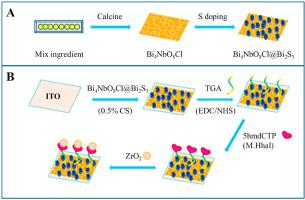Biosensors and Bioelectronics ( IF 10.7 ) Pub Date : 2021-08-24 , DOI: 10.1016/j.bios.2021.113580 Jia Ding 1 , Yunlei Zhou 1 , Qian Wang 1 , Shiyun Ai 1

|
As an important epigenetic modification, 5-hydroxymethylcytosine (5hmC) aroused wide concern about the distribution and the function. Due to the necessity of 5hmC detection, a novel photoelectrochemical (PEC) biosensor was established based on the in-situ generated heterojunction of Bi4NbO8Cl@Bi2S3, which was employed as the substrate material with excellent photoelectric property. The specific recognition of 5hmC relied on the covalent reaction between –CH2OH of 5hmC and –SH on the substrate electrode under the catalysis of M.HhaI methyltransferase. Afterwards, ZrO2 was used as signal amplification unit capturing by the specific reaction of Zr with the phosphate group of 5hmC. The experimental results demonstrated well specificity and sensitivity of this biosensor. Under optimal conditions, the linear relationship between the photocurrent and the logarithm value of 5hmC concentration was constructed with the range from 0.3 - 300 nM and the detection limit of 0.0779 nM (S/N = 3). The procedures of constructing this biosensor were compact and convenient, and this biosensor realized actual detection of 5hmC level in wheat sample. Significantly, this biosensor was applied to a preliminary study that the heavy metal Pb2+ and the perfluorooctanoic acid influence the expression of 5hmC in the genomic DNA of wheat seedling roots and leaves.
中文翻译:

基于原位合成Bi4NbO8Cl@Bi2S3异质结光活性增强的用于DNA羟甲基化检测的光电化学生物传感器
作为一种重要的表观遗传修饰,5-羟甲基胞嘧啶(5hmC)的分布和功能引起了广泛关注。由于5hmC检测的必要性,基于原位产生的Bi 4 NbO 8 Cl@Bi 2 S 3异质结,建立了一种新型光电化学(PEC)生物传感器,该异质结被用作具有优异光电性能的基板材料。5hmC的特异性识别依赖于5hmC的-CH 2 OH与底物电极上的-SH在M.HhaI甲基转移酶的催化下发生共价反应。之后,ZrO 2Zr与5hmC的磷酸基团发生特异性反应,用作信号放大单元捕获。实验结果表明该生物传感器具有良好的特异性和灵敏度。在最佳条件下,构建了光电流与5hmC浓度对数值的线性关系,范围为0.3-300 nM,检测限为0.0779 nM(S/N=3)。该生物传感器的构建程序紧凑、方便,实现了小麦样品中5hmC水平的实际检测。值得注意的是,该生物传感器应用于重金属Pb 2+和全氟辛酸影响小麦幼苗根和叶基因组DNA中5hmC表达的初步研究。









































 京公网安备 11010802027423号
京公网安备 11010802027423号